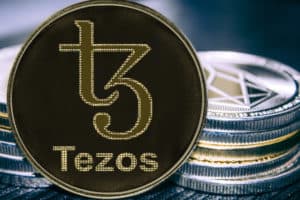2018-12-12 22:57 |
Although it is a relative newcomer to the blockchain market, Tezos has been propelled through the ranks after enduring a rocky start. Tezos offers dApp blockchain features that make it comparable to Ethereum or EOS, but Tezos’ underlying blockchain introduces significant technical innovations. This guide provides a broad overview of the Tezos platform.
Table of Contents What is Tezos? Legal Roadblocks The Long-Awaited Launch The Technology Behind Tezos Liquid Proof-of-Stake Consensus Verifiable Smart Contracts Self-Amending Updates Tezos Advantages Tezos Disadvantages How to Buy Tezos Tezos Wallets Conclusion What is Tezos?Tezos was conceived by Kathleen and Arthur Breitman as a platform that would fulfill the same role as Ethereum: a programmable blockchain capable of supporting decentralized applications.
Tezos Co-founder Arthur Breitman
However, Tezos was also an attempt to innovate on existing consensus mechanisms, governance models, and upgrade practices. In short, Tezos was meant to be a flexible blockchain that would operate smoothly and continuously.
Tezos finally came into existence in 2017, when the Breitmans held an ICO to raise money for the project. This ICO campaign raised $232 million, making Tezos the largest ICO at that time. The project also gained high-profile investments from firms such as PolyChain Capital and independent investors such as Tim Draper. However, Tezos would soon face legal issues that would threaten the success of the project.
Legal RoadblocksA few months after Tezos’ ICO ended, the Breitmans entered a dispute with Johann Gevers, who served as co-founder and president of the Tezos Foundation. This dispute concerned intellectual property ownership and Tezos’ free software license. In addition to causing Gevers to part ways with Tezos, this also caused Tezos’ launch to be delayed.
More critically, the dispute prevented Tezos tokens from being distributed to ICO investors. As a result, investors filed a number of lawsuits against Tezos, arguing that the project’s tokens were unregistered securities. These lawsuits sought refunds, although Tezo’s ICO had called investments “non-refundable donations,” which complicated matters.
The Tezos tokens were eventually distributed in June 2018 when Kathleen Breitman took the initiative to push through the project despite legal uncertainties. Unfortunately, more complications came with this decision: investors who had already purchased tokens were forced to comply with KYC identity checks. This quickly split the Tezos network into two parts: the standard Tezos chain, and an alternative chain without KYC called nTezos.
The Long-Awaited LaunchThe standard Tezos network ultimately prevailed, putting the project back on track. Tezos’ first testnet was finally launched on June 30th, 2018, and this version of the platform was used to gradually implement and test the platform’s technical features. Later, in September 2018, the Tezos mainnet was launched, bringing the platform to the public. Tezos has now attracted over 450 “bakers” who produce blocks, plus many more general users.
The Technology Behind TezosLike all blockchains, Tezos uses a series of blocks to manage transaction data and other information. It also has a unique consensus mechanism, upgrade system, and programming language, all of which are explained below.
Liquid Proof-of-Stake ConsensusConsensus is the manner in which blockchain participants come to an agreement on the validity of blocks on a blockchain. Tezos’ consensus mechanism can be described as a combination of traditional and delegated proof-of-stake.
Traditional proof-of-stake, which is used in Ethereum’s upcoming Casper protocol, allows node operators to lock up their own tokens for a chance to validate blocks and earn token rewards. This system allows an unlimited number of nodes to vie for control over block validation, and the fact that countless stakers can exist makes the model highly decentralized. Unfortunately, staking is too expensive for many basic users: even if Ethereum lowers the minimum staking amount to 32 ETH, staking will still require thousands of dollars.
Meanwhile, delegated proof-of-stake (DPoS) allows users to stake their tokens in order to vote for a limited number of block producers. EOS, for example, elects only 21 block producers, all of whom are large organizations that must dedicate massive amounts of computing power. This model has come under fire for centralizing power in the hands of a few block producers. However, delegation and voting make it possible for less wealthy users to have an indirect say over the course of the blockchain.
Tezos combines these two models with its unique “liquid proof-of-stake” mechanism. This model allows up to 80,000 block validators or “bakers” to accept delegated tokens. Bakers must hold 10,000 XTZ, which is, again, thousands of dollars. However, Tezos also allows users with smaller holdings to delegate their tokens to bakers and receive rewards in return. In other words, liquid proof-of-stake permits users to either become a full-fledged block validator or merely delegate tokens to validators.
The following infographic gets into some of the specifics of the baking process, which involves unique features like a “quality assurance team” and a “bonding” or “cooldown” phase:
Verifiable Smart ContractsJust like Ethereum and EOS, Tezos supports smart contracts, which are blockchain programs that can execute automatic transactions. However, Tezos uses its own programming language, which is called Michelson. Michelson is Turing-complete, meaning that it has a level of complexity that is found in almost all current programming languages. That means that Michelson can be used to program almost any modern program.
Additionally, Michelson allows for formal validation, a process that mathematically detects problems in code. This process is not perfect, but it does catch some bugs that would otherwise become costly when exploited by hackers.
Ethereum and EOS also have some third-party projects that are attempting to implement formal verification, but Tezos already has this feature built into its smart contract language. Incidentally, Cardano’s Haskell language also has formal verification features.
Self-Amending UpdatesTezos is self-amending, meaning that it does not need to go through regular hard forks in order to be upgraded. Even when hard forks are agreed upon by an entire network, they can create a lot of work for developers and node operators. Tezos has a more seamless upgrade process that does not involve regularly forking the blockchain.
That said, it is possible for part of the network to decide to fork Tezos — indeed, this has already happened during the initial KYC controversy.
Tezos Advantages Affordable staking: Tezos provides a relatively affordable way for users to stake or delegate their tokens and receive rewards. There is no minimum amount of tokens that a user must delegate, although some bakers may set their own limits. Users who delegate their tokens receive payouts every seven cycles (approximately 20 days). Accessible governance: Tezos combines the best features of proof-of-stake and delegated proof-of-stake. In addition to generating and distributing token rewards, liquid proof of stake gives most participants a chance to influence the network, either directly or indirectly. Seamless upgrades: Blockchains may experience downtime or price fluctuations around the time of routine hard fork upgrades — this was recently a problem for Steemit, for example. Tezos can avoid those issues with its self-amending ledger. Verifiable smart contracts: Tezos’ smart contracts may provide improved security and resistance against attackers thanks to its formally verifiable contracts. Admittedly, the absence of attacks on Tezos is partially due to the fact that the platform hosts very few dApps at the moment. Education initiatives: Tezos has offered generous grants in order to encourage developers to study the platform. So far, Tezos has given away at least $30 million worth of grants and is working with Kingsland University to provide online training. Tezos Disadvantages Lack of commercial support: Although it is technically impressive, Tezos is not widely supported in commercial transactions, nor is this a major goal of the platform. Although XTZ tokens may be appropriate for investors, bakers, and delegators, those who intend to spend their crypto should stick with Bitcoin, Ethereum, or another leading coin. Immature network: Much of Tezos’ development team has a focus on programming language theory, possibly to the detriment of other areas. Although the network has gained a considerable amount of users, it is still fairly young and has not reached its capacity. It is difficult to predict what Tezos’ transaction fees and transaction speeds will be once the platform becomes more widely used, and developers have been mostly silent on this matter. Delegation issues: Tezos allows users to delegate their tokens to bakers and receive rewards, as noted above. However, the growth of the network has caused many popular bakers to surpass their capacity, causing a number of users to miss out on their rewards without being notified. A solution to this problem is still uncertain as of December 2018. Past controversies: Tezos’ past legal issues resulted in key Tezos figures (including Johann Gevers) leaving the organization. Although Tezos has restored its public image and seems to have a stable organization, it is not clear whether new divisions between key figures will form. How to Buy TezosThe Tezos coin (XTZ) can be obtained through a number of prominent exchanges, including Kraken and Bittrex. Each exchange has different trading pairs, meaning that you can purchase XTZ by spending ETH, BTC, Tether, or fiat currency.
A complete list of Tezos trading pairs is available on CoinMarketCap. Additionally, reviews of most major exchanges are available on Unhashed. These resources can help you decide which exchange to purchase coins on.
It should be noted that Gate.io, an otherwise minor exchange, trades a substantial amount of XTZ tokens. This is because Gate.io is involved with the Tezos baking process and distributes rewards to users of the exchange.
Since Gate.io is a minor exchange, this reward scheme is not recommended: you should instead purchase tokens from a well-known exchange and delegate tokens to trusted bakers.
Suggested Reading : Learn more about Kraken and Bittrex respectively, here and here.
Tezos WalletsUnlike most cryptocurrencies, the Tezos team has not introduced an official wallet, nor does it intend to. Although the Tezos client does provide a command-line tool that serves this purpose, most users should select a community-developed wallet that is easy to use. There are several options to choose from:
Tezbox: Tezbox was the first-ever Tezos wallet, which makes it a reliable choice. It supports mobile devices and desktops, although it can also be accessed through a desktop web browser. It stores addresses locally on your device, which is a good security practice. Tezbox may also appeal to developers, who can integrate the wallet with their dApps. Kukai: Kukai is a desktop wallet that supports Windows, Mac OSX, and Linux. A web interface is also available. Notably, it features offline transaction signing, which implements security in a manner similar to hardware wallets. Tezos.blue: Tezos.blue is available for Android, iOS, and Windows. Like Tezbox, it can be used by developers to connect a wallet to an application. Galleon: Galleon is a desktop wallet for Windows, Mac, OSX, and Linux. It has a fairly basic GitHub page with little information and few instructions; it may not be a good choice for new users.Wetez: Wetez is a mobile wallet for Android and iOS. It promotes itself as a security-focused wallet. However, its security features are fairly basic: it stores private keys locally, a standard practice that is also carried out by Tezbox and other wallets. Magnum: Magnum is a web wallet. Unlike some web wallets, it merely is accessed through a web browser and does not store coins or private keys online. It stores private keys on your device, just like desktop wallets do. Hardware wallets: Ledger (via a Tezbox plugin) and Trezor also support Tezos.
It is important to ensure that you are obtaining your wallet from the correct source. It is possible for phishers to upload fake software that impersonates a real wallet.
Although Tezos has not yet suffered such an attack, this problem has become increasingly common on app stores. Whenever possible, download wallets directly from official websites rather than through an app store.
ConclusionDespite a rough start, Tezos has become a promising platform. It offers impressive technical innovations in the areas of consensus, smart contract security, and upgrade procedures. It has also attracted a fair amount of users and “bakers.” The XTZ token has achieved an impressive total value: as of December 2018, it is resting at #22, with a market cap of $342 million, and has remained in line with the overall crypto market for several months.
However, market cap is not everything. Tezos is still quite young, and it will have to attract plenty of app developers if it wants to succeed against up-and-coming app-focused blockchains like NEO and TRON. Tezos’ generous development grants may facilitate app development, although this is far from certain. Additionally, the platform’s lack of focus on commercial applications and user experience may hamper Tezos’ popularity with general audiences.
The post What is Tezos? | The Complete Beginner’s Guide appeared first on UNHASHED.
origin »Tezos (XTZ) на Currencies.ru
|
|




















